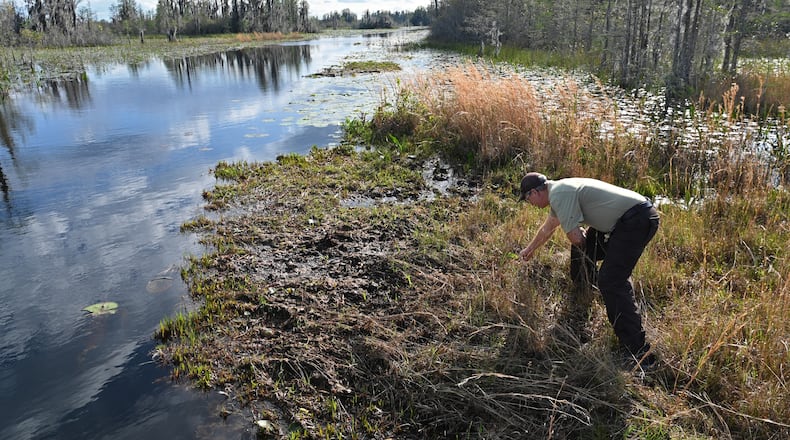With a hotly contested plan to mine near Georgia’s Okefenokee National Wildlife Refuge waiting on final approval, the federal agency in charge of the sanctuary has floated a new expansion plan that eyes adding the land where the mine has been proposed to its footprint.
The U.S. Fish and Wildlife Service released a proposal Friday to expand its “acquisition boundary” by adding 22,000 acres to the roughly 407,000-acre refuge, including land where Alabama-based Twin Pines Minerals wants to extract titanium sands. For the last five years, Twin Pines has been seeking permits to develop a nearly 600-acre mine on Trail Ridge, a line of mineral-rich sand dunes that run along the swamp’s eastern edge. The primary end product the company is after is titanium dioxide, a whitening pigment used in toothpaste, paint and more.
Draft permits for the mine were released back in February, bringing the project closer to becoming reality, but the company is still waiting for final sign-off from the Georgia Environmental Protection Division.
The move by FWS is only the first step toward expanding the Okefenokee and will not block the company from continuing its quest to mine. The proposal would, however, open the door for the agency to work with willing landowners nearby to acquire their properties or explore other conservation solutions to protect the refuge.
The territory FWS wants to add would expand the size of the refuge by about 5%.
The agency said its expansion plan would “strengthen protection of the hydrological integrity of the swamp” and protect its rare and endangered wildlife. The Okefenokee is the largest blackwater swamp in North America and is home to red-cockaded woodpeckers, gopher tortoises, indigo snakes, American alligators, wood storks and thousands of other species.
The FWS proposal also calls for the creation of a one-mile “fuel reduction zone” around the refuge to prevent the spread of wildfires.
Fires have always occurred in the Okefenokee and help cycle nutrients through the ecosystem, but several large blazes have torn through the swamp in recent years. Some of those infernos have spilled into commercial timberlands, causing hundreds of millions of dollars in damage.
Twin Pines president Steve Ingle said in a statement that the press release issued by the FWS on Friday was the first time the company had heard of the proposal.
“We have not spoken with the U.S. Fish and Wildlife Service and our plans to commence mining upon permit approval are unchanged,” Ingle said.
Hyosub Shin/AJC
Hyosub Shin/AJC
Georgia EPD spokeswoman Sara Lips also said the agency is moving forward with its review of Twin Pines’s permits.
“EPD is continuing to evaluate and review the surface mining application submitted by Twin Pines Minerals,” Lips said.
Twin Pines has been adamant the mine will not harm the swamp or its wildlife. So far, EPD has indicated it shares that view.
But outside scientists, including hydrologists from the University of Georgia and FWS, say the company has failed to prove it won’t harm the ecosystem. Critics claim the mine — which, if permitted, could be allowed to suck nearly 1.5 million gallons a day from the underlying aquifer — could wreak ecological devastation and open the door for thousands more acres to be mined.
This year, FWS also sent a letter to EPD Director Jeff Cown arguing the groundwater withdrawals the company is planning would siphon water from the swamp. In its letter, the agency said it is “concerned that the issuance of a permit at this juncture would not preserve sufficient water” for the refuge.
Hyosub Shin/AJC
Hyosub Shin/AJC
Environmentalists opposed to Twin Pines’s mine praised the FWS plan to expand the refuge.
Georgia River Network executive director Rena Ann Peck called the proposal a step in the right direction toward protecting the swamp and Trail Ridge, the ancient dune complex key to the Okefenokee’s hydrology.
“Scientists say that to protect what’s inside the swamp, you have to protect what’s on the outside and that’s Trail Ridge, the hydrogeologic dam holding water in the swamp,” Peck said in a statement.
The public will now have a chance to weigh in on FWS’s proposal.
Comments can be submitted by email through Nov. 18, 2024, to Okefenokee@fws.gov. A public meeting is also scheduled for Nov. 12 from 6:30 to 8 p.m. at the Charlton County Annex Auditorium at 68 Kingsland Drive in Folkston, Georgia.
Editor’s note: This story has been updated to reflect the new date of the public meeting FWS plans to hold on its proposed expansion of the Okefenokee National Wildlife Refuge’s acquisition boundary.
About the Author








